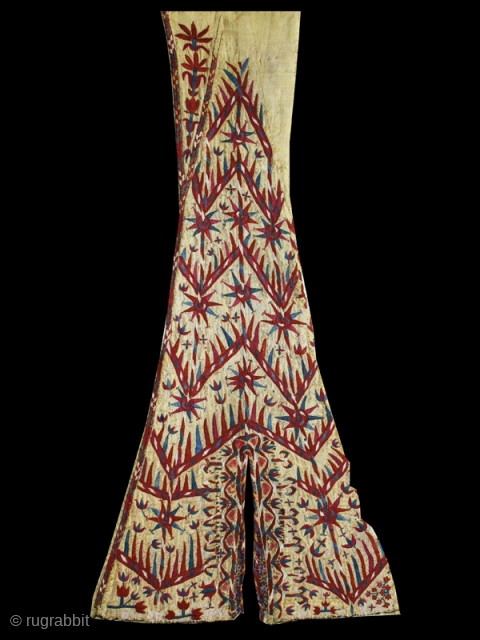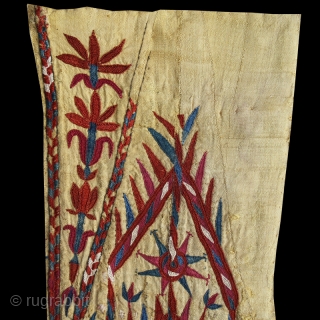Back
Woman’s yellow Chyrpy fragment cod. 0679. Silk embroidery on silk. Turkmen people. Central Asia. Early 19th. century. Cm. 42 x 81 (16.5 x 32 inches).
Sewn onto black canvas and mounted on a wooden stretcher.
The Turkmen embroidery tradition is rooted in the belief that their intricate and beautiful needlework provides magical protection through birth, childhood and marriage. Different tribes have distinctively different ways of dressing. The chyrpy is a ceremonial garment most commonly associated with the Tekke tribe, and worn as a cloak over the head and shoulders. Made of silk, chirpys are covered with brilliant embroidery – mostly red with touches of yellow and white on a black background with tassels along the bottom. They have false sleeves, joined with an embroidered band and hanging at the back.Chyrpys are generally embroidered by women and use a “kesdi” silk lacing stitch to make the small motifs. The main embroidery pattern is of a stylised tulip – which occurs commonly throughout the region – arranged in geometric bunches. Other typical patterns include rhombuses adorning the collar and various border elements such as the diamond-shaped pishme, so-called because it resembles the traditional Turkmen fried snack served with green tea during celebrations. The fish motif represents another ubiquitous requirement in Turkmen life: that of good fortune and the provision of protection.The chyrpy also illustrates a woman’s social status. a dark blue or black chyrpy is worn by a younger woman, while married or middle-aged women will wear yellow and, in old age, white. White chyrpys would be relatively rare, worn only by a woman typically at least 60 years old and recognised within the community as having been a “good woman”.
price:
P.O.R.
- Home
- Antique Rugs by Region
- Category
- Profiles
- Post Items Free
- Albums
- Benaki Museum of Islamic Art
- Budapest: Ottoman Carpets
- Gulbenkian Museum
- Islamic Carpets. Brooklyn
- Islamic Textiles. Brooklyn
- Konya Museum: Rugs
- MKG, Hamburg
- MMA: Caucasian Carpets
- MMA: Mamluk Carpets
- MMA: Mughal Indian Carpets
- MMA: Ottoman Carpets
- MMA: Safavid Persian Carpets
- MMA: Turkmen Rugs
- McCoy Jones Kilims
- Ottoman textiles. Met
- Philadelphia Museum
- Rugs and Carpets: Berlin
- Seljuqs at the Met
- TIEM, Istanbul: Carpets
- V&A: Classical Carpets
- Vakiflar Carpets: Istanbul
- Baluch Rugs: Indianapolis
- Gallery Exhibitions
- Jaf an Exhibition
- Alberto Levi Gallery
- Andean Textile
- Christie's London: 2016
- Francesca Galloway
- HALI at 40
- ICOC Washington, DC 2018
- Jajims of the Shahsavan
- London Islamic Week April, 2018
- Mongolian Felts
- Navajo Rugs: JB Moore
- Persian Piled Weavings
- SF Tribal & Textile Art Show 2020
- SF Tribal 2019
- Sotheby's: C. Alexander
- Turkish Prayer Rugs
- Turkmen Main Carpets ICOC 2007










